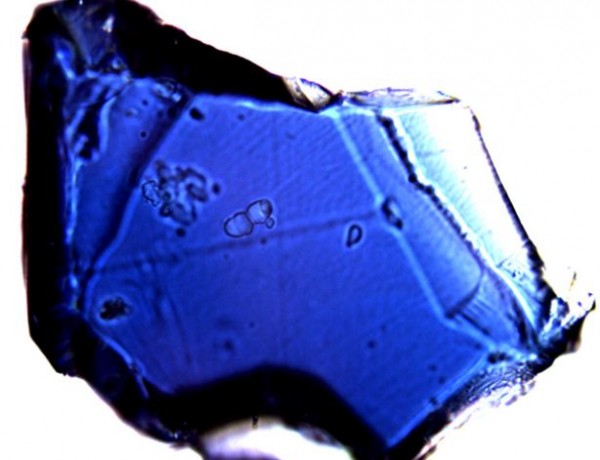Scientists Confirm the Existence of an Ocean Deep Inside the Earth
| Arthur Dominic Villasanta | | Jun 14, 2014 09:05 AM EDT |
Sample of a ringwoodite crystal thought to hold much of the Earth's sub-surface water
The world's largest ocean lies 400 to 600 kilometers beneath our feet. But all that water's trapped inside a special type of rock called "ringwoodite."
Scientists have long suspected that a so-called "transition zone" in the Earth's mantle could contain water trapped in rare minerals. That transition zone lies between the upper and lower mantle layers which are 410 kilometers to 660 kilometers below the surface.
Like Us on Facebook
Direct evidence for this water has now been confirmed for the first time.
Scientists in the US conducted experiments on ringwoodite, a water-rich mineral, by analyzing seismic waves travelling through the mantle beneath the US. They discovered that downward-flowing mantle material was melting as it crossed the boundary between the transition zone and the lower mantle layer.
This led researchers to conclude there has to be this water in the transition zone because of this melting. Melting is a way of getting rid of water, which is unstable under conditions in the Earth's lower mantle, said the researchers.
A new study published a few days ago in the journal Science said the transition zone "... can hold a lot of water, and could potentially have the same amount of H2O (water) as all the world's oceans."
Most of this water in this sub-surface "ocean" is trapped inside ringwoodite. This is a rare type of mineral that forms from a mineral called olivine under very high pressures and temperatures such as those present in the mantle's transition zone.
Olivine, also called peridot or chrysolite, is a magnesium iron silicate mineral common in the Earth's sub-surface.
Sceintific studies have shown that ringwoodite can contain water. This water isn't present as liquid, ice or vapor, however.
Instead, the water is trapped in the ringwoodite's molecular structure as hydroxide ions or bonded oxygen and hydrogen atoms.
Scientists have previously used many approaches to look for evidence of Earth's interior water reservoir. This is the first time scientists have searched for clues of the reservoir by focusing on the potential water-induced melting at the bottom of the transition zone.
The new findings will help scientists better understand Earth's water cycle. Scientists know that the surface water we now have comes from degassing of molten rock. It came from the original rock ingredients in the Earth. The question now facing scientists is how much water is still inside the Earth today relative to the surface.
TagsEarth transition zone, Earth underground ocean, ringwoodite, sub-surface water
©2015 Chinatopix All rights reserved. Do not reproduce without permission
EDITOR'S PICKS
-

Did the Trump administration just announce plans for a trade war with ‘hostile’ China and Russia?
-

US Senate passes Taiwan travel bill slammed by China
-

As Yan Sihong’s family grieves, here are other Chinese students who went missing abroad. Some have never been found
-

Beijing blasts Western critics who ‘smear China’ with the term sharp power
-

China Envoy Seeks to Defuse Tensions With U.S. as a Trade War Brews
-

Singapore's Deputy PM Provides Bitcoin Vote of Confidence Amid China's Blanket Bans
-

China warns investors over risks in overseas virtual currency trading
-

Chinese government most trustworthy: survey
-

Kashima Antlers On Course For Back-To-Back Titles
MOST POPULAR
LATEST NEWS
Zhou Yongkang: China's Former Security Chief Sentenced to Life in Prison

China's former Chief of the Ministry of Public Security, Zhou Yongkang, has been given a life sentence after he was found guilty of abusing his office, bribery and deliberately ... Full Article
TRENDING STORY

China Pork Prices Expected to Stabilize As The Supplies Recover

Elephone P9000 Smartphone is now on Sale on Amazon India

There's a Big Chance Cliffhangers Won't Still Be Resolved When Grey's Anatomy Season 13 Returns

Supreme Court Ruled on Samsung vs Apple Dispute for Patent Infringement

Microsoft Surface Pro 5 Rumors and Release Date: What is the Latest?









